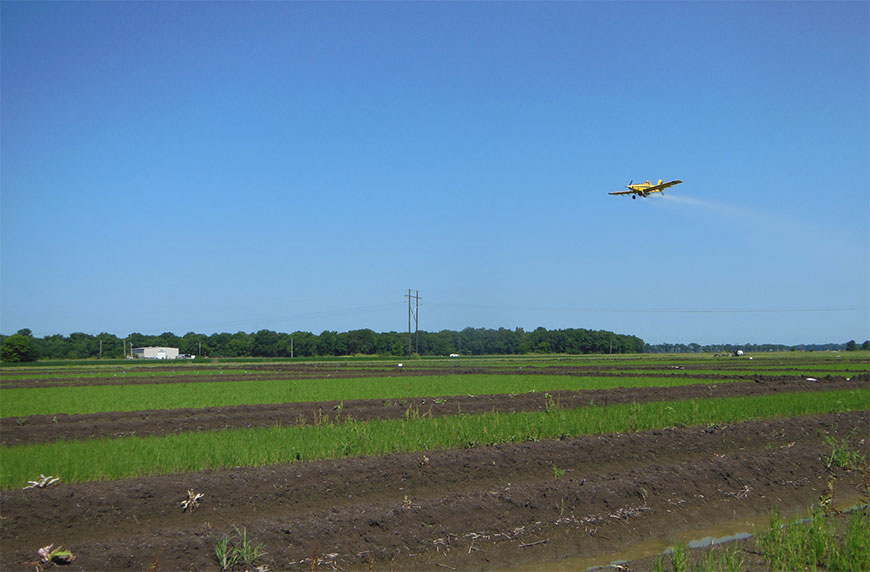News
The information presented on this page may be outdated. It may refer to situations which have changed or people who are no longer affiliated with the university. It is archived as part of Mississippi State University's history.
Nitrogen applied as usual in new rice growing plan

A new way of growing rice keeps costs down while maintaining yields, and Mississippi State University researchers say the method does not hinder application of the key fertilizer. (Photo By: Lee Atwill)
1/20/2017
By: Bonnie Coblentz
Alternate wetting and drying, or AWD, is a method for growing rice that allows fields to dry out before farmers flood them again. The conventional method of growing rice uses a continuous flood over the paddy.
Lee Atwill, an MSU Extension Service associate and agronomy doctoral student, said the key to alternate wetting and drying is establishing a continuous flood on the front end when nutrients are applied, weeds are controlled and the rice is established.
"The key to maximizing nitrogen use efficiently for alternate wetting and drying is to maintain a continuous flood for 21 days after preflood nitrogen is applied, and then begin the alternate wetting and drying management," Atwill said.
Bobby Golden, Extension rice specialist [and scientist in the Mississippi Agricultural and Forestry Experiment Station] , explained the importance of nitrogen in any rice growing system.
"Nitrogen is the No. 1 nutrient input needed to maximize rice yield in most situations," Golden said. "Research data shows you can apply 100 percent of the nitrogen fertilizer requirement preflood, hold that flood for three weeks, and yields will be optimal."
"If the preflood nitrogen rate is misapplied, mistimed or mismanaged, you can recoup some yield with a midseason application," he said.
Nitrogen is applied to rice fields as urea, a granule that is subject to losses through volatization if not incorporated quickly into the soil. Golden said urea is incorporated in rice fields with the flood water. Adding a urease inhibitor allows growers additional time to establish a permanent flood while minimizing volatization losses of nitrogen.
"The flood allows the plants to take up the nitrogen in the form most useful to them," Atwill said. "About 70 to 80 percent of preflood-applied nitrogen is take up in the first 21 days as growers maintain a 4-inch flood."
Atwill said once nitrogen is properly applied preflood, growers can use the alternate wetting and drying method for rice production.
If growers using alternate wetting and drying decide to apply additional nitrogen during the growing season, they must bring the field back to flood level and then apply urea.
Alternate wetting and drying is a research-proven rice management technique that cuts water use by up to one-third while maintaining yields. While the practice is not suitable for every rice field, farmers use it on about 20 percent of Mississippi rice fields.
"We intentionally allow the rice field to dry down after the initial flood, which is radically different than the recommendations across the Rice Belt," said Jason Krutz, Extension irrigation specialist and Mississippi Agricultural and Forestry Experiment Station researcher. "We establish the flood again before harvest, but rather than letting the rice grow in 2 to 4 inches of standing water during the majority of the growing season, we let the field dry to where water is 4 inches below the soil surface before flooding it again."
"Using alternate wetting and drying, we've been seeing a 30 percent reduction in water use and no change in yield," Krutz said. "The economic advantage is our AWD fields are coming in about $50 ahead from water savings."
Atwill said MSU researchers are defining best management practices that allow growers to learn how to manage an alternate wetting and drying system that works for them.
"We give growers the tools they need to start, teach them how to do it and what safe practices are," Atwill said. "Many are choosing to implement it on their own farms."
View More News